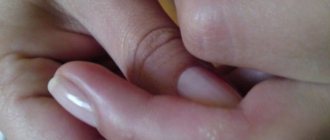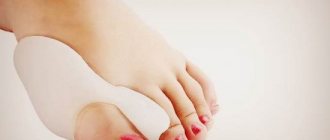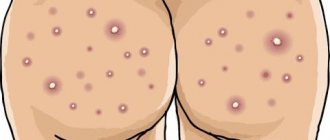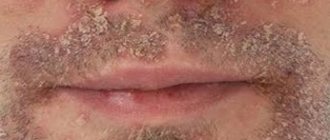- May 21, 2019
- Child's health
- Olga Simchenko
A callus is a local thickening of the skin. It is formed by pressure on the toes, heels and feet or friction. Dry calluses look like growths or bumps, while wet calluses look like small wounds. They are characterized by severe pain and require proper treatment to avoid infection. In addition, there are calluses with a core that require medical intervention.
Types of calluses
As soon as a child begins to walk, there is a possibility of chafing and calluses forming on the feet. Typically, a child develops calluses such as:
- wet;
- dry;
- rod.
A wet callus is a bubble filled with liquid. It is formed as a result of prolonged friction or compression of the foot. Fluid forms between the layers of skin, which protects the injured area from infection. Therefore, if there is no urgent need, then you should not open the dropsy.
Normally, the liquid inside the dropsy is clear, but if the wound gets infected, the contents can become purulent. In this case, antibacterial therapy is required. When the blood vessels are damaged, the contents of the bladder turn red.
A dry callus looks like a hard bump on a child's foot. It is much less common than dropsy. Corns have clear boundaries, they are dense and rough to the touch. Their color is light yellow and grayish and consists of keratinized parts of the skin.
Rarely do children develop core calluses. They are formed due to the gradual germination of dry cells into the deep layers of the skin. Such calluses are painful, cause serious discomfort when walking, and therefore require treatment. Most likely, the dermatologist will prescribe mechanical removal of the growth.
How to treat corns
Corns in children usually occur due to wearing incorrect shoes or the anatomical structure of the foot. Therefore, the first thing we do is remove the irritating factor - change or select good shoes.
Next, we take baths - baby skin absorbs substances well, and the problem should go away quickly. The most popular ones are with laundry soap and soda or with herbs. The main thing here is to come up with a reason and keep the child in a basin of water for 20 minutes. A good way is to throw plastic caps into the water and ask them to catch them with their toes. This way, the procedure will have double benefits - you’ll take a bath and train your motor skills.
Afterwards, treat these areas with a pumice stone or a finely sanded nail file. Movements should be light. Immediately after, wipe your feet dry and apply a rich cream over the corns. Then we put on our socks and go to bed listening to my mother’s fairy tale. Well, what a hero, he deserves it!
If desired, the bath can be combined with swimming. Only the solutions should be herbal.
Reasons for appearance
The following reasons provoke the appearance of a wet callus on a child’s foot:
- new shoes;
- shoes that are too tight or too big;
- rollers are not the right size;
- rough seams inside the shoes;
- large socks or tights;
- playing sports.
Unworn sneakers or sandals rub and lead to the formation of calluses on a child's feet. Small children cannot tell how comfortable they are in shoes. Parents should monitor this regularly. It is necessary to take into account that the leg grows quickly, therefore, it is imperative to select the correct size.
It is also important to check how children's shoes are sewn. The seams should be soft enough and it is important that they do not cut into the skin.
Corns appear when walking barefoot for a long time, as well as in case of irregular gait or flat feet. A callus with a core on a child’s foot appears due to constant rubbing of a certain area of the skin with various hard materials. It is also formed when the skin of the foot is damaged by a fungal infection.
What is a callus
A callus is a conical thickening of the skin that occurs in areas of constant friction or pressure. Most often, calluses appear on the feet (heel, big toe, side of the foot) and on the hands. In men, a callus may appear on the penis due to frequent wearing of too tight underwear.
The main symptom of the appearance of callous formations is the formation of tubercles of rough skin. Depending on the location and appearance, there are several types of calluses:
- dry;
- wet;
- bone.
A dry callus is a small area of thickened, dead skin that is yellowish in color. A wet callus has a thinner surface and is often filled with lymphatic fluid. Callus occurs during the process of bone regeneration after fractures. Separately, bloody calluses, core calluses, and calluses are also distinguished.
Core (root) callus is a type of dry callus and is distinguished by the presence of a thickened keratin core. The external manifestation of a root callus is similar to that of a plantar wart, so a dermatologist can make an accurate diagnosis after performing a dermatoscopy.
Calluses (corns) are wide, flat thickenings of the skin that do not have a hard center. Corns on the feet and hands rarely cause pain when pressed.
A callus with blood is a type of wet callus filled not only with lymph, but also with blood. A callus occurs when blood vessels are too close to the surface of the skin that has been subjected to friction.
Which doctor should I contact?
If parents discover a callus on their child’s foot, they can try to cope with the existing problem on their own. But it is best to consult a doctor who will prescribe the correct treatment.
First of all, you should visit a dermatologist. The doctor will be able to distinguish the problem being studied from other skin diseases. A fungus that can be confused with a dry callus can lead to thickening of the skin on the foot. The fungus is a more dangerous disease than the one being studied and requires appropriate treatment.
Treatment Options
How to treat a callus on a child’s foot can be determined by the attending doctor after an examination. It is better to start therapy at an early stage, as this promotes faster recovery.
The surgeon opens the wet callus, but it is important to take all precautions. Initially, he treats the blister with an antibacterial agent, numbs it and opens it. At the end of the procedure, the doctor applies an anti-inflammatory ointment to the wound and applies a bandage or plaster. Parents should change the patch periodically.
If a child has dry calluses, the dermatologist will prescribe baths and compresses that you can prepare yourself. They do not irritate the skin, but soften the crusts on the foot. The steamed stratum corneum is removed with pumice.
If there is a core callus, treatment can be carried out using laser removal. This is a modern safe method that has virtually no contraindications.
Medical diagnosis of callus
Core-type calluses are fairly easy to diagnose.
After an in-person consultation, a dermatologist can provide a conclusion and diagnosis about the type of skin growth.
The only difficulty may be differentiating an ingrown callus from Verruca plantaris (plantar wart).
Because they have the same location and appearance.
You can distinguish a callus from a wart by the following features:
- An ingrown callus is not accompanied by bleeding even with strong pressure on it.
- A wart, unlike a callus, is not a single formation. Typically, upon examination, several warts that resemble cauliflower can be identified.
- The callus in its central zone has a small depression, which can be seen upon detailed examination. In the case of a wart, the HPV formation consists of thin fibers; petechiae (black dots) are observed on top, which bleed when injured.
- If a wart is present, pain occurs when the lesion itself is palpated; there is no pain when walking. In the case of calluses, pain is observed with any mechanical movement.
To confirm the diagnosis and determine the cause of the disease, the dermatologist prescribes a blood test for diabetes mellitus.
Also an analysis to determine the human papillomavirus, to exclude HPV.
Additionally, the doctor can redirect the patient to other specialized specialists.
See a podiatrist (a doctor who treats foot pathologies), a rheumatologist or an orthopedist.
An important point is to exclude Morton's neuroma.
Morton's neuroma is a benign or non-cancerous growth of fibrous tissue.
Develops in the area of the tibial nerve, most often between the third and fourth fingers.
The pathology is accompanied by thickening of the plantar nerve, pain when walking, and a feeling of numbness in the fingers.
The disease is also known as Morton's metatarsalgia, plantar neuroma, and intermetatasal neuroma.
Treatment of wet calluses. Peculiarities
If a child has rubbed a callus, then there is no need to pierce the dropsy yourself. It's worth seeing a doctor. If the dropsy is small, he will treat it with an antiseptic and cover it with a bactericidal bandage.
If the callus on the child’s heel is large enough and prevents him from moving, then the doctor treats the dropsy with a disinfectant, makes a puncture, and presses down a little so that the liquid comes out. Then the surface of the blister is treated with an antiseptic and the wound is sealed with a bactericidal plaster.
It is worth remembering that the top part of the callus must remain in place and cannot be torn off or cut off. If such a callus bursts on its own and the upper skin is torn off, then you need to seal the wound with a bactericidal bandage with a healing cream. For example, "Bepanten".
Callus
Callus formation is an important step in the process of bone tissue repair after injury because it helps connect the parts of the damaged bone. After a fracture, the callus is enriched with calcium and gradually turns into normal bone tissue.
Due to insufficient immobilization or poor circulation at the fracture site, callus may form too slowly (delayed fracture consolidation). Its slow formation can cause the bone to heal incorrectly and cause pain.
Treatment of dry calluses
If corns appear, then you should not ignore the existing problems. Despite the fact that these are fairly harmless neoplasms, over time they can degenerate into rod-like growths, which are quite difficult to get rid of.
Before treating a dry callus on a child’s foot, the feet should be thoroughly steamed in a warm bath for 20 minutes. Then carefully remove the softened layer using pumice, apply baby cream and put on socks. The baby should sleep in them all night.
If this does not help, then you can use pharmacy or folk remedies. If they are unsuccessful, you need to show the child to a surgeon. Perhaps it is not a dry callus, but a plantar wart. And this is already dangerous.
Treatment of calluses with a rod
This is a dense keratinized growth on the foot or toes, which has a cap and a shaft that extends deep into the skin. This type of callus is very difficult to treat. Initially, you need to apply a patch with salicylic acid to it. It is important to ensure that the drug-impregnated part of the patch only touches the keratinized skin.
Instead of salicylic acid, you can use anti-callus ointment, but you also need to use it very carefully so that it does not affect healthy skin.
If the callus is severely neglected, the doctor may prescribe drastic treatment methods. For children, doctors generally prescribe cryodestruction, during which the callus along with the rod comes out of the socket. This technique is completely painless, which allows it to be successfully used to treat children.
Methods for treating and removing ingrown calluses
The only and effective method of eliminating this problem on the legs is to remove the stratum corneum of the callus and its root.
In this case, it is important to completely remove not only the surface of the callus, but also the root.
Otherwise, the risk of relapse reaches 100%.
There are various methods for removing calluses; the optimal treatment option is selected individually.
Depending on the clinical signs, the neglect of the case and how deep the root has penetrated into the layers of the dermis.
Drug treatment
If a callus has formed on a child’s foot, treatment must be carried out very carefully, since children’s skin is delicate and can be easily damaged. Any cream or ointment has an aggressive effect on the baby’s body and can lead to allergies. You can use medications only as prescribed by a doctor.
Salicylic ointment is considered one of the most effective remedies. When using it, it is very important to strictly follow the instructions. At the first sign of an allergy, you should immediately consult a doctor.
There are many ointments, creams and solutions for corns. There are also special patches that are easy to use and considered quite effective. The patch is simply glued to the resulting growth and after a while the desired result is achieved.
The simplest “Aspirin” will help remove a callus on a child’s foot. To do this, grind 10 tablets to a powder, dilute with water and mix with a spoon of lemon juice. Apply the resulting mixture to the affected area, cover with film and wrap it up so that the growth warms up well. After 10 minutes, rinse off the mixture and remove the callus itself with a pumice stone. This is a pretty simple method.
To treat dry calluses, you can use such products as “Salipod”, “Stop-callus”, “Frizonel”.
4.Treatment
When opening a soft callus at home, the first priority is antiseptic measures: the affected area should be thoroughly washed and disinfected, the needle should be sterilized (it is better to use the sterile needle included with any disposable syringe). After opening and expiration of the contents, the wound surface should also be treated with a disinfectant solution, carefully remove flaps of dead skin with a sterilized manicure instrument (do not tear off under any circumstances!), apply antibiotic ointment and, if necessary, a protective bandage or bactericidal patch. There is also a wide range of traditional medicine, the consideration of which is beyond the scope of this article.
To eliminate and prevent dry calluses, therapeutic and hygienic creams, gels, ointments, and liquids are offered; You can also find countless recommendations for steaming, using pumice, softening compresses, etc. However, it is more important to remember the following.
At the first signs of an infectious-inflammatory process, as well as when a rapid change in the size, shape, color of the callus and/or sensations associated with it begins, you should immediately consult a doctor (surgeon or dermatologist). Currently, many methods for the safe removal and treatment of calluses are successfully used, taking into account the individual nuances of each case: radio wave, laser, cryotherapeutic, microsurgical techniques.
Mechanical removal
A callus on the sole of a child's foot causes significant discomfort. Therefore, it must be removed immediately after its appearance. Only a doctor can prescribe mechanical removal of callous tumors. Among the main removal methods, the following should be highlighted:
- cryodestruction;
- laser treatment;
- electrocoagulation;
- radio wave treatment.
Cryodestruction means that liquid nitrogen is applied to the callus, after which it freezes and is torn off on its own. Only a small trace remains, which disappears after a while.
Laser treatment is characterized by the fact that local exposure is carried out, while healthy skin is not damaged. After removing the callus, there are no traces left.
Electrocoagulation involves exposure to high-frequency current, which destroys the growth. The procedure lasts 10 minutes and leaves no traces.
Radio wave treatment – evaporation of the callus along with the core. The method is contactless and leaves no traces.
How to cure water blister
What to do if a water callus has formed on your leg? Small dropsies quickly go away on their own. To protect against injury, it is recommended to cover the inflamed area with a bactericidal plaster for 1-2 days and not wear tight shoes.
Large water calluses on the feet cause aesthetic and physiological discomfort and therefore require treatment. The optimal therapeutic method is opening or puncture. It is recommended to pierce the callus on the first day the blister appears.
Is it possible to pierce an inflamed callus yourself? In order to avoid wound infection, all manipulations should be carried out with clean hands and a sterile needle. If it is not possible to ensure sterility and thorough surface treatment, it is better to open the dropsy in a doctor’s office.
Self-puncture of a watery callus on the leg is carried out as follows:
- Treat the callus and surrounding skin with an antiseptic solution (alcohol, brilliant green, hydrogen peroxide, iodine).
- Take a sterile needle from an injection syringe. If you don’t have such a needle, you can heat a regular pin over a fire or disinfect it in medical alcohol.
- The needle is inserted into the water callus parallel to the surface of the skin (on the side of the bladder). It is not recommended to pierce water blisters on the legs in the central part because... this can injure the bottom of the callus.
- For good outflow of fluid, it is necessary to make 2-3 punctures, while maintaining the integrity of the walls of the bladder.
- When the punctures are made, the water bubble is slowly pressed against the surface of the skin with a sterile bandage or gauze to squeeze out all the liquid present in the cavity.
- A bactericidal patch is applied to the dropsy. The walls of the released bladder cover the inflamed skin inside the callus, protecting the wound from infection.
- The patch or bandage on calluses must be changed 2 times a day and removed at night.
There are cases when, after a few days, the water callus is again filled with intercellular fluid. Then the puncture should be repeated.
Water bladder suppuration
If there was suppuration in the callus, it is necessary:
- open the water callus and remove the infected bladder walls;
- treat the wound with an antiseptic;
- apply antibiotic ointment to the weeping wound;
- cover the affected area of skin with a gauze pad and adhesive tape.
The inflammatory process and suppuration in the water callus, which are accompanied by an increase in body temperature and the growth of the area of redness, are localized on an outpatient basis, in the surgical office. The specialist will clean the wound area, apply a bandage with drainage if necessary, and prescribe antibacterial therapy.
Treatment of water callus with folk remedies
- A proven folk method for treating water blisters on the legs and arms is salt baths. A warm saline solution (1 teaspoon per 1 liter of water) or a strong solution of potassium permanganate disinfects well and softens the callus, accelerating healing.
- Aloe juice is considered another effective remedy. Aloe pulp is a natural antiseptic that relieves inflammation and accelerates healing. A plant leaf cut along the surface or a swab soaked in aloe juice is placed on the water bladder. This compress is fixed with a bandage and changed every 4-6 hours. To treat a small callus, you can use regular plantain. A leaf washed in cold water must be mashed until the juice appears and applied tightly to the callus. After 4-5 hours, the application is repeated.
- Lemon has a good antiseptic and softening effect. For water blisters, it is recommended to apply an application of grated pulp and lemon peel to the damaged area of skin and hold for up to 5 minutes. It will be enough to apply 2 compresses during the day so that the next day the pain goes away and the callus decreases.
If the water bubble bursts on its own
Due to excessive pressure or mechanical damage, the water callus may burst. Spontaneous opening is accompanied by painful discomfort and burning. The open wound should be disinfected and covered with a bactericidal bandage. If after a few days the area of redness around the callus increases and suppuration is noticeable, such symptoms indicate infection of the burst callus and require immediate contact with a specialist.
Water calluses on the soles require special attention. If the skin on your feet is rough and prone to calluses, dropsy can become a painful ingrown callus.
Folk remedies
You can try to get rid of dry calluses using folk remedies. These include:
- raw chicken egg;
- aloe;
- soda and soap;
- potato;
- sunflower oil;
- garlic;
- honey.
Place a raw chicken egg in vinegar. When it is completely dissolved, apply the resulting liquid to the callus and put on woolen socks. This procedure should be done before going to bed.
Apply the pulp of an aloe leaf to the sore spot. Secure it with adhesive tape and put on woolen socks. Grate raw potatoes, apply the resulting pulp to the problem area and secure with a band-aid.
A honey mask helps a lot. Initially, you need to rinse the corns well, then lubricate them with natural honey and cover them with film. Wear warm wool socks on top. Leave it on all night. In the morning, clean the callus with a pumice stone and lubricate the affected area with cream. You can also use propolis as a compress. To do this, you need to steam your feet and apply a propolis compress. Wear for two days and then repeat the procedure.
When using folk remedies, you need to be careful, as some components can trigger allergies.
Carrying out prevention
You should avoid wearing new shoes for a long time. During a long walk or travel, it is better to offer your child old, comfortable shoes. In extreme cases, you need to make sure that he has something to change shoes into if discomfort occurs.
Socks and tights must match the size of the child’s feet to avoid the formation of lumps. Particular attention should be paid to the insole. It should be the size of the shoe, not bent or crumpled.
After heavy loads on the legs, the child needs a relaxing massage or a warm foot bath. It is imperative to purchase high-quality shoes made from natural materials.








